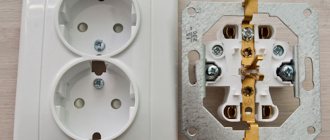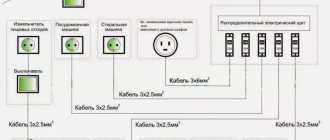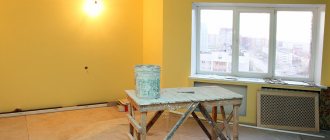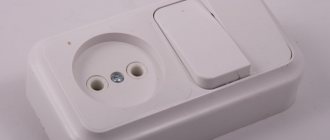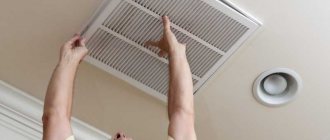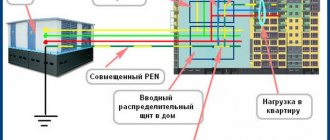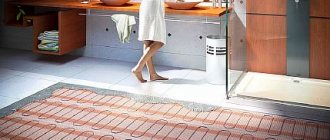Often, when designing a kitchen set, difficulties arise due to the inconvenient location of the outlet for the electric stove. However, the issue can be resolved, you just need to figure out step by step how to move the outlet to a new location. It is extremely important to solve this problem correctly, since the frequency of use of the stove is high and the result of incorrect actions can be a breakdown of the device or even a fire in the apartment.
Dismantling
Any move begins with the installation of a new mounting box, dismantling the old outlet and its power line from the distribution box. When performing this action, it is important not to damage the system of the entire apartment.
You should start moving the electric stove socket by removing the voltage from the network you are going to work with. Pay attention even to the possibility of accidental touches, they can be very dangerous.
Usually there is a separate switch for the electric stove in the panel. But it is still strongly recommended to check the power point with a two-pole voltage indicator.
The dismantling progress looks something like this:
- After removing the old outlet, it is important to check whether all its wires are intact and undamaged, especially if you have a power point with a voltage of 380 V.
- In order for the stove to work correctly, pay special attention to the order of connecting the phase, neutral and protective wires, since their incorrect connection can lead to a short circuit.
- If initially, when installing the network, they relied on the PUE (Electrical Installation Rules), then blue should be used for the neutral wire, and yellow-green for the protective wire. If these tips are missing, you need to mark all the cable cores yourself.
- When the socket is in your hands, carefully inspect all its parts. The presence of any visual defects is a strong argument for purchasing a new product. The only serious cause for concern is the presence of a slight burnt spot in the contact part, which can be removed independently with ordinary sandpaper.
Working surface
How to properly remove power, and where is the best place to do it for small household appliances? Finding the answer to this question is a serious challenge for many.
Here it is necessary to take into account the possibility of simultaneously connecting the necessary kitchen appliances. For example, it is quite possible that you will need to turn on a kettle, toaster, coffee machine and mixer in one zone, so it is advisable to remove the block of 4 sockets in the appropriate place.
Naturally, it is impossible to provide for everything, so it is recommended to additionally provide for a reserve.
As practice shows, there are never too many sockets. It is considered normal to place blocks at 3–4 points at intervals of 1000–1200 mm along the entire length of the work area table top.
Please note that, for safety reasons, it is prohibited to install sockets closer than 500 mm from the gas pipe riser and wet areas, including the sink mixer.
In relation to the tabletop, electrical fittings should be placed at a height of at least 100–150 mm, which is 900–950 mm from the floor level. The final dimensions are determined taking into account the selected tile - so that the blocks fall on its center. If the electrical installation has begun, but there are no tiles, it is enough to simply separate the wires with a reserve, and install the socket boxes closer to the start of the tiling work.
Preparatory work
To move an outlet, you need to do the following:
- Choose a place for a new nest.
- The determining factor when choosing a location is ease of use. However, there are a number of rules that must be followed:
- To connect a new power point for an electric stove, it is recommended to use a VVGng power cable with a cross-section of at least 1.5 mm2;
- The line can only be laid vertically or horizontally. If it is more convenient for the project to route the cable horizontally, then the groove should be 200 mm from the ceiling and 100 mm from the beams and cornices. And if vertically, then you need to retreat 100 mm from doors, window openings and corners of the room;
- The distance from the floor should be at least 50 cm and no more than 80 cm. Radiators, steel pipelines and gas stoves should be at a distance of more than half a meter;
To connect or make a branch of the electrical cable, you will need the help of a special distribution box or a nearby point, from which it can subsequently be powered.
- In order to most rationally choose the location of the new point, it is recommended to first draw a diagram of its connection.
- We scratch the walls and make a recess for the “glass”.
- To install a new socket box, you need to make a groove for laying the cable and prepare the place where the “glass” will be located. To drill such a hole, you will need a special crown, and if you don’t have one, you can use a hammer drill that has an impact drill or a grinder. The work cannot be completed without certain skills in using equipment.
A special “glass” is installed in the prepared socket, through the back wall of which an electrical wire is inserted. The socket box is fixed with a gypsum solution, the excess of which must be removed after complete hardening.
Extension cord for electric stove
The easiest way to move an electric stove or hob some distance from a power outlet in the kitchen is to use an extension cord.
Everything is simple here, we plug the extension cord into the existing socket, connect the connector itself to the new installation location of the stove, and this, in fact, completes the transfer.
The main advantages of this transfer method are:
- Simplicity. Using an extension cord, any person who does not have any special knowledge and skills in electricity and electrical installation can easily move the outlet for the stove to the place they need.
- Low cost. This solution will most likely be the most cost-effective, because you will only need to buy an extension cord for the electric stove.
Unfortunately, this method also has serious disadvantages that make this method of transfer undesirable:
— Lack of extension cords for electric stoves . It is quite difficult to find an extension cord for an electric stove on sale, especially if a three-phase connection is used. Since the electric stove is the most energy-intensive device in the apartment, the extension cord uses a large cross-section cable, as well as a special power outlet designed for high current. In addition, a large variety of power connectors of various types complicates the selection task.
Most likely, you will have to assemble such an extension cord yourself by purchasing the appropriate cable, plug and socket.
— Unreliable connection . When using an extension cord, several unnecessary connections appear in the power supply circuit of the electric stove, some of them detachable, which sharply reduces the reliability of the entire system. There is a high probability of contacts loosening and heating, which often leads to fire.
— Possibility of mechanical damage to the power cable . When moving an electric stove, the electrical cable is most often laid openly, simply placed on the floor or passed through furniture, for example, across a kitchen unit. In such conditions, there is a high probability of mechanical damage to the cable under various circumstances - this could be rodents, chafing of the cable, pets or children, or simply a break as a result of careless work nearby.
- The appearance of the room is spoiled. In everyday life, we are surrounded by many electrical appliances, all of which are plugged into an outlet. The kitchen is probably one of the most loaded rooms with various equipment; if you do not organize the connection points correctly, you can simply “drown” in the wires; they will interfere not only with cleaning the room and moving around it, but also simply irritate you with their appearance. Therefore, an extension cord for an electric stove lying on the floor will not add attractiveness and practicality to your kitchen.
— Possibility of electric shock to a person . Elements of electrical wiring accessible to people, which include an extension cord, are dangerous in themselves because they can, under certain conditions, for example, if the insulation is damaged, cause harm to human health through electric shock. In addition, due to the presence of water in the kitchen, these risks increase significantly, because pipes or plumbing fixtures may burst, and, what happens even more often, your neighbors above may flood you. In such conditions, using an extension cord becomes especially dangerous.
As you can see, this method has more disadvantages than possible benefits; the extension cord should be used only as a temporary solution, until the implementation of a more reliable, complete, comprehensively safe one, such as those presented in the following paragraphs of our article.
Wire routing.
A cable is laid into the prepared “glass” along a hollowed out groove (groove in concrete), which will supply the stove with electricity.
A violation of the established norms and rules for moving sockets is the presence of connections on the line. It would be best to replace it, especially if a fairly large extension is required. It is also strongly recommended to make an installation reserve when running the cable from the junction box in order to avoid repeated work if this wire needs to be extended again. In reality, this is usually difficult to implement, so preference is given to connecting such a cable, which, according to the PUE, can be done by crimping, welding, soldering or using compression. For self-extension, clamp terminals are usually used, since the first three connection methods require special equipment.
The terminals are:
- Quick-clamping or screw with special brass tips - if you need to connect flexible copper conductors;
- Self-clamping - if you need to connect an aluminum wire.
If you need to connect rigid copper conductors, you can use any terminals.
How to install it yourself?
It’s not difficult to figure out the correct wiring and installation of wiring boxes. The main operations are carried out even before the finishing of the premises.
- Having decided on the consumers and locations for installing the sockets, they move on to marking them on the walls.
- The center is outlined, after which a hole 40–60 mm deep is made with a 63 mm crown for the “socket box”. If you don’t have a special tool, you can get by with a chisel and a hammer. Many professional electricians prefer to work with a grinder and a hammer drill.
- Then you can proceed to securing the mounting box with the wire passed into it. Usually fixation is done using building gypsum or plaster mixture. It is permissible to use special glue.
- After “cementing”, all voids and cracks around the perimeter of the box are sealed with plaster.
The length of the protruding wire must be at least 150 mm so that when connecting, you can easily install a socket or switch.
Methods for transferring a connection point
There are two simple methods that allow you to transfer sockets without destroying the wall finish:
- By creating a loop - involves creating a jumper from the old “point” to the new connection point.
- By extending the wire - involves extending the electrical line in the cavity of the new groove.
If the new chosen location is much further than the previous one, you can make a complete replacement of the entire line by laying a separate wire from the distribution box located at a slight distance. But, unlike the two methods described above, laying a new line requires large-scale repair work.
When choosing a daisy chain method for connecting a new outlet, keep in mind that such a connection is very unreliable for installing three or more power points. If one section or socket is damaged, the entire sequential chain of devices will be inoperative. And, according to the rules of the PUE, it is not allowed to be used to power powerful electrical appliances: microwaves, electric stoves, refrigerators, washing machines, etc.
Another negative side is that when two sockets are connected with a single cable, the current load sequentially passes from one device to another. Therefore, when several devices are plugged into sockets connected through jumpers at the same time, there may not be enough voltage for their operation.
FAQ
Question No. 1: How can you create a reliable connection of wires when moving a socket at home? The simplest and most affordable methods are crimping and soldering. To perform crimping, special pliers and a sleeve crimped on both sides, made of the same metal as the wire, are used. Question No. 2: What can result from poor quality work? When moving an outlet, each step should be taken responsibly. Otherwise, there is a high probability of sparking, melting and ignition of parts of the housing, and a short circuit.
Preparation for installation
Let’s try to answer the question that worries many: “How to make a socket with your own hands?” Since this process is not simple, we will explain in detail each working nuance.
A separate power supply line is provided to power the electric stove. It follows from the regulatory documents that for a furnace with a power of up to 8 kW, it is desirable to have a separate circuit breaker with a rated current value of 25 amperes.
At the second stage, the selection of wires takes place, so copper must have a cross-section of at least 2.5 mm^2, aluminum - from 4 mm^2.
If it is impossible to connect a separate power line and you plan to connect the electric stove to the general apartment network, then, according to the standards, it must be powered from a machine that conducts a current of 40 amperes.
Replacing electricity with gas
It is impossible to live in a house without gas. Gas stoves are not allowed in electrified houses. This reconstruction cannot be approved, since the apartment building must have a gas distribution system, and the premises must meet certain requirements. In this case, clause 7 is taken into account.
36 SNiP 01/31/2003 “Residential multi-apartment buildings”. Although earlier in clause 6.29 of SNiP 2.04.08-87* “Gas supply” it was stipulated that “the installation of gas stoves in residential buildings should be provided in kitchens with a height of at least 2.2 m, having a window with a window (transom), an exhaust ventilation channel and natural light. In this case, the internal volume of kitchen premises must be, m2, not less than:
- for gas stove with 2 burners. . . . 8,
- for gas stove with 3 burners. . . . 12,
- for gas stove with 4 burners. . . . 15".
Despite the fact that this SNiP has ceased to be valid, the requirements have remained virtually unchanged.
Conclusions and useful video on the topic
The video will talk about how to move a socket without dust:
What to consider when moving a connection point:
There is nothing complicated about moving an outlet to a new location. The main thing is to adhere to the recommendations of experienced electricians listed in the article and observe safety precautions.
If, while reading the information, you have questions or have recommendations that will help a novice master cope with moving the socket, please write them in the block below.

